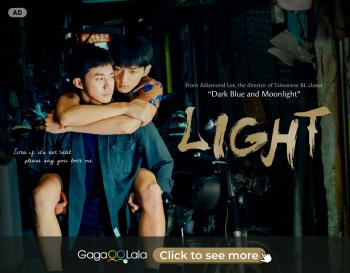Author: George Po Chun Huang
Venice Biennale founded the Biennale College Cinema, aiming to promote new filmmakers' emerging works. Lebanese editorial director Mazen Khaled's second feature film, Martyr (2017), is one of the works that saw the light trough this project. Lebanese movies are rare, not to mention films Lebanese films challenging homoeroticism and suicide, taboos for the Muslim world.
Watch Martyr on GagaOOLala
Hassane, who is sleeping in the living room, is awakened by his parents. His parents are complaining about his unemployment. Well-educated, Hassane argues that he simply refuses to be humiliated in workplaces. He rides his motorbike to the sea, encountering Mahdi, a friend whom he has lost contact with for a very long time. Watching people jumping into the sea from the top of the walls, Hassen makes an even more extreme decision to jump from the sidewalk over the wall, and dive into the sea, as if he wanted to let his unconsciousness take care of his life and death.

Still from Martyr / (Source: GagaOOLala)
The film starts with a close-up of Hassen staring at the camera lens, breaking the fourth wall, following a series of close-ups of his skin, hair, hands, back, and hips, revealing the fact that he does not want to be just a common person. The scene where Hassen is soaked in dark water resembles Under the Skin (2013), and where it seems like dreaming in water reminds us of Mulholland Drive (2001). Both of these brilliant works contain images of sex and death.

Still from Martyr / (Source: GagaOOLala)
There are also many symbols related to male homoeroticism, insinuating the hyper-visibility and ubiquitousness of gay people in Muslim society. When Hassen is taking shower, we see, through his eyes, that he is stroking his penis; when Hassen goes to pick up his friend Mohammad, the two are in swimsuits, showing their thighs; Mohammad is sitting in the backseat, hands put on Hassen's waist; Hassen sist on the beach with three of his friends, bare-chested, watching a group of men, also bare-chested, playing soccer; the four men play in the water and touch each other's bodies; a group of naked men carry or surround a man; Mohammad imagines that he spends time with Hassen along, holding him, leaning on his back, and stroking his chest hair.

Still from Martyr / (Source: GagaOOLala)
In addition to underwater photography, the film also demonstrates other forms of contemporary arts. Multiple men carry Hassen's body; Mohammad and his friends create a scene where six arms surround each other's bodies; when Hassen is carried on the sidewalk, the people lift him high above in the air; when Hassen's corpse returns home, he walks in his room and lies down, as if he were a witness to his own death; along with the elegy at the ceremony, Mohammad and Hassen's body perform a ceremonial dance; Hassen's mother mourns while singing, swaying with Hassen's sister, while other women stand behind them. These scenes demonstrate very well director Mazen Khaled's idea to unravel the story through images and motions.

Still from Martyr / (Source: GagaOOLala)
When Hassen and Mohammad are talking by the seashore, Mohammad is glad that both of them did not end up like Mahdi, a street gangster; Hassen, however, says that their unemployed and aimless life is no better than Mahdi, and that Mohammad should not judge him. Hassen reveals that he always obeys his parents and he has always felt terrified of the future. Unable to gain freedom, he thinks that a gangster like Mahdi who lives in the present is one of the few truly free persons. This conversation reflects how lost the well-educated youngsters feel about life and, perhaps, also the despair of being unable to come out.

Still from Martyr / (Source: GagaOOLala)
After receiving the bad news about her son, Hassen's mother seems to be seeing Hassen in her head. Hassen asks her to look at him, but she cannot face him. Then, Hassen becomes Mohammad, stroking her hair tenderly. Hassen's father has a friend that asks the priest to bath his corpse, but Hassen's father asks Hassen's three friends to undertake the task. These subplots seem to indicate that Hassen's parents already know about Hassen's homosexuality and the intimate relationship between Hassen and Mohammad. Even so, they still refuse to face it. It is not until the last moment that they softly accept that this is probably the cause for Hassen's death.

Still from Martyr / (Source: GagaOOLala)
Martyr is the one who sacrifices for one's religion or belief. When Hassen's corpse returns home, Mahdi has a clash with Mohammad. When Hassen is at the threshold of his home, Mahdi screams that Hassen has already immolated. These scenes reveal that perhaps Mahdi knows that Hassen's martyrdom is a result of his sexuality. Later, when Mohammad and Mahdi mourn in peace, Mohammad says that Hassen keept mentioning him; when they hold each other in their arms, Mohammad also says that Mahdi played an important role in Hassen's life, indicating that Mahdi and Hassen might have been lovers before. Mohammad and other two friends bath Hassen's corpse, as if washing away the inescapable guilt of being a gay Muslim, and the sea symbolizes their final liberation.

Still from Martyr / (Source: GagaOOLala)


















